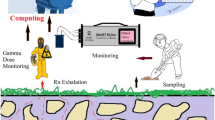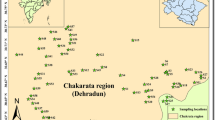Abstract
Indoor radon is considered as one of the potential dangerous radioactive elements. Common building materials and soil are the major source of this radon gas in the indoor environment. In the present study, the measurement of radon exhalation rate in the soil and building material samples of Una and Hamirpur districts of Himachal Pradesh has been done with solid state alpha track detectors, LR-115 type-II plastic track detectors. The radon exhalation rate for the soil samples varies from 39.1 to 91.2 mBq kg−1 h−1 with a mean value 59.7 mBq kg−1 h−1. Also the radium concentration of the studied area is found and it varies from 30.6 to 51.9 Bq kg−1 with a mean value 41.6 Bq kg−1. The exhalation rate for the building material samples varies from 40.72 (sandstone) to 81.40 mBq kg−1 h−1 (granite) with a mean value of 59.94 mBq kg−1 h−1.




Similar content being viewed by others
References
Abu-Jarad F, Fremlin J H and Bull R 1980 A study of radon emitted from building materials using plastic track detectors; Phys. Med. Biol. 25 (4) 683–694.
Ademola J A 2008 Determination of natural radionuclides content in some building materials in Nigeria by gamma-ray spectrometry; Health Phys. 94 43–48.
Bahi El S. 2004 Assessment of radioactivity and radon exhalation rate in Egyptian cement; Health Phys. 86 517–522.
Bollhöfer A, Storm J, Martin P and Tims S 2006 Geographic variability in radon exhalation at a rehabilitated uranium mine in the northern territory, Australia; Environ. Monit. Assess. 114 313–330.
Bruzzi L, Mele R and Padoani F 1992 Evaluation of gamma and alpha doses due to natural radioactivity of building materials; J. Radiol. Prot. 12 67–76.
CEC 1990 Recommendation de la Commission Relative a la Protection de la Population Contre les Dangers Resultant de l’Exposition au Radon a l‘Interieur des Batiments; Commission des Communautes Europeennes, Brussels.
Eappen K P, Ramachandran T V, Shaikh A N and Mayya Y S 2001 Calibration factor for SSNTD-based radon/ thoron dosimeters; Radiat. Protect. Environ. 24 (1–2) 410–414.
El-Bahi S M 2004 Assessment of radioactivity and radon exhalation rate in Egyptian cement; Health Phys. 86 517–522.
Farai I P and Ademola J A 2005 Radium equivalent activity concentrations in concrete building blocks in eight cities in southwestern Nigeria; J. Environ. Radioact. 79 119–125.
Folkerts K H, Keller G and Muth R 1984 An experimental study of diffusion and exhalation of222Rn and220Rn from building materials; Radiat. Prot. Dosim. 9 27–34.
Ismail A H and Jaafar M S 2010 Hazards assessment of radon exhalation rate and radium content in the soil samples in Iraqi Kurdistan using passive and active detecting methods; World Acad. Sci. Eng. Technol. 70 701–704.
Kaul R, Umamaheshwar K, Chandrasekaram S, Deshmukh R D and Swarnkar B M 1993 Uranium mineralization in the Siwalik of northwestern Himalaya, India; J. Geol. Soc. India 41 243–258.
Khan M S, Naqvi A H, Azam A and Srivastava D S 2011 Radium and radon exhalation studies of soil; Iran J. Radiat. Res. 8 (4) 207–210.
Kumar J, Malhotra R, Singh J and Singh S 1994 Radon measurements in dwellings in radioactive areas in Himachal Pradesh, India, using LR-115, plastic track detectors; Nucl. Geophys. 8 (6) 573–576.
Maged A F and Borham E 1997 A study of the radon emitted from various building materials using alpha track detectors; Radiat. Meas. 28 613–617.
Mehra R, Singh S and Singh K 2006 A study of uranium, radium, radon exhalation rate and indoor radon in the environs of some areas of the Malwa region, Punjab; Indoor Built Environ. 15 499–505.
Munazza F and Matiullah 2008 Radon exhalation and its dependence on moisture content from samples of soil and building materials; Radiat. Meas. 43 1458–1462.
Mustonen R 1984 Natural radioactivity in and radon exhalation from Finnish building materials; Health Phys. 46 1195–1203.
Organization for Economic Cooperation and Development (OECD) 1979 Exposure to radiation from natural radioactivity in building materials. Report by a group of Experts of the OECD Nuclear Energy Agency; OECD, Paris.
Ramachandran T V and Subba Ramu M C 1989 Estimation of indoor radiation exposure from the natural radioactivity content of building materials; Oncol. 3 20–25.
Schery S D, Whittlestone S, Hart K P and Hill S E 1989 The flux of radon and thoron from Australian soils; J. Geophys. Res. 94 8567–8576.
Shanbag A A, Sartandel S J, Ramachandran T V and Puranik V D 2005 Natural radioactivity concentrations in beach sands of Ratnagiri coast, Maharastra; J. Assoc. Environ. Geochem. 8 304–308.
Sharma D K, Kumar A, Kumar M and Singh S 2003 Study of uranium, radium and radon exhalation rate in soil samples from some areas of Kangra district, Himachal Pradesh, India using solid state nuclear track detectors; Radiat. Meas. 36 363–366.
Singh S, Kumar A and Singh B 2002 Radon level in dwellings and its correlation with uranium and radium content in some areas of Himachal Pradesh, India; Environ. Int. 28 97–101.
Turhan S 2008 Assessment of the natural radioactivity and radiological hazards in Turkish cement and its raw materials; J. Environ. Radioact. 99 404–414.
United Nations Scientific Committee on the Effects of Atomic Radiation 2000 Sources and Effects of Ionizing Radiation; New York.
Zaidi J H, Arif M, Ahmad S, Fatima I and Qureshi I H 1999 Determination of natural radioactivity in building materials used in Rawalpindi/Islamabad area by γ-ray spectrometry and instrumental neutron activation analysis; Appl. Radiat. Isot. 51 559–564.
Acknowledgements
The authors are thankful to the residents of the study area for their cooperation during the sample collection, and to the Department of Physics, NIT, Jalandhar, for providing us the research facilities at their laboratories.
Author information
Authors and Affiliations
Corresponding author
Additional information
Corresponding editor: K Krishnamoorthy
Rights and permissions
About this article
Cite this article
Bala, P., Kumar, V. & Mehra, R. Measurement of radon exhalation rate in various building materials and soil samples. J Earth Syst Sci 126, 31 (2017). https://doi.org/10.1007/s12040-017-0797-z
Received:
Revised:
Accepted:
Published:
DOI: https://doi.org/10.1007/s12040-017-0797-z




